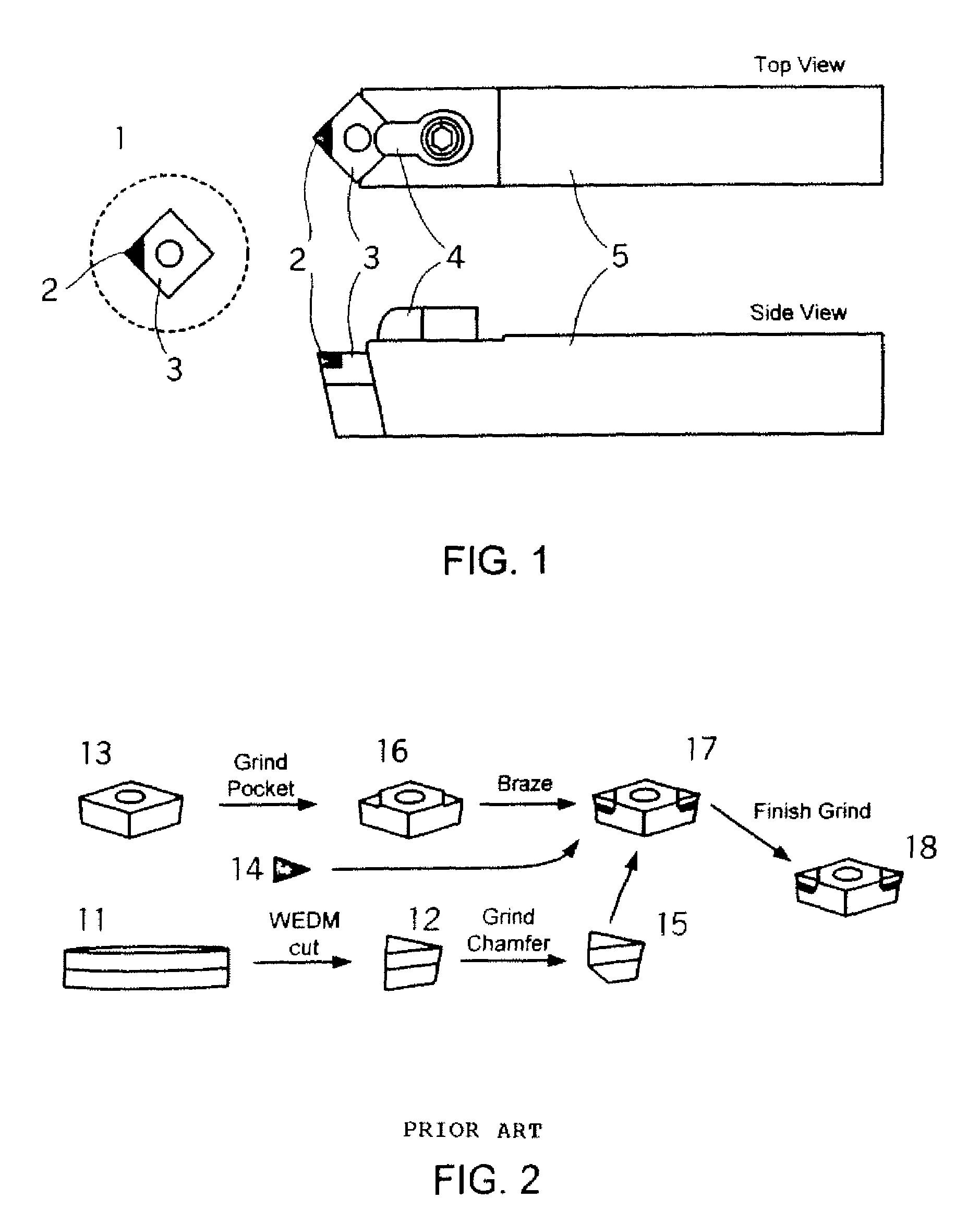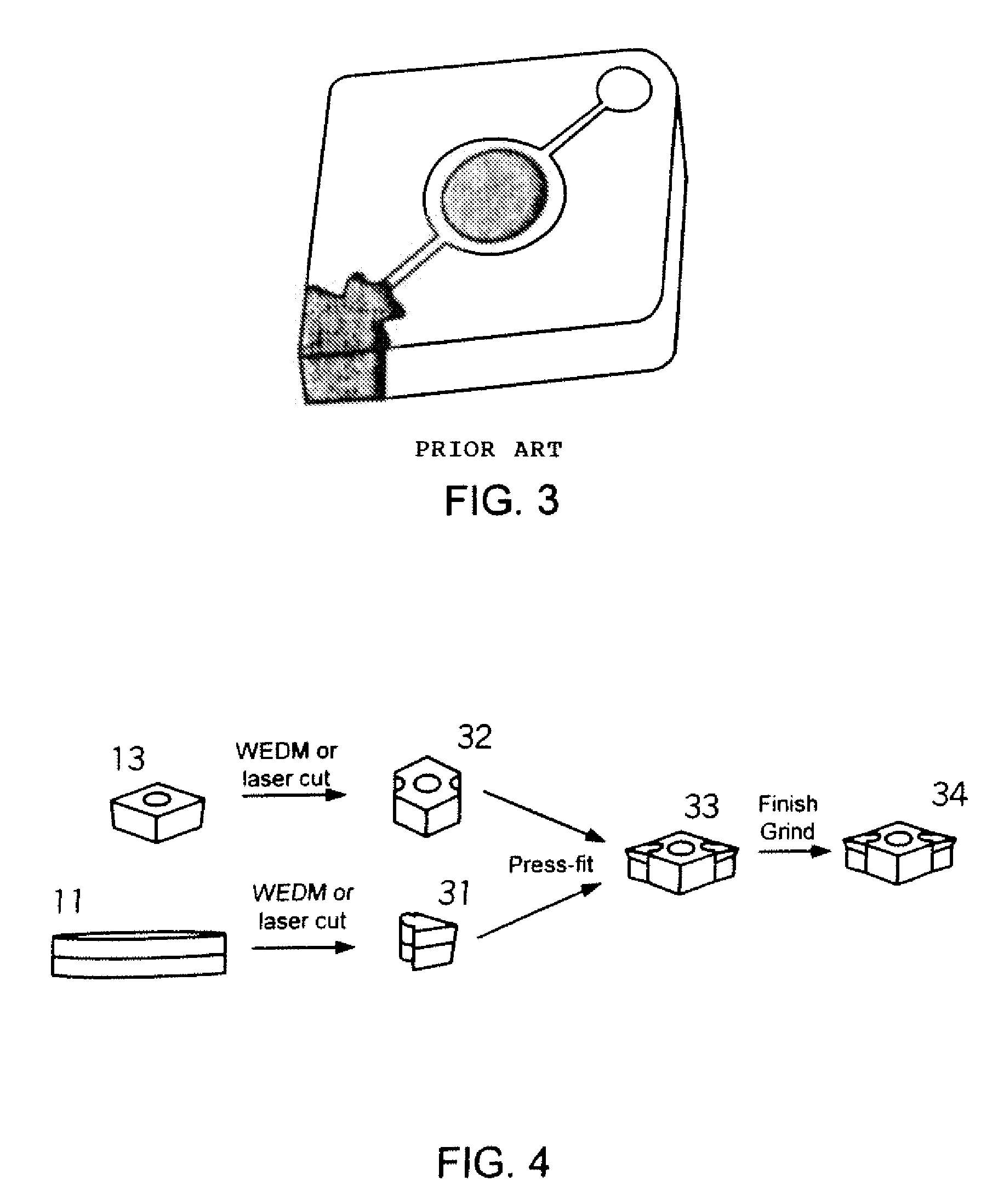Cutting tool inserts and methods to manufacture
- Summary
- Abstract
- Description
- Claims
- Application Information
AI Technical Summary
Problems solved by technology
Method used
Image
Examples
example 1
[0071]Two mechanically bonded inserts are prepared by the press-fit embodiment with mating and interlocking dovetail geometry similar to that pictured in FIG. 6A. The abrasive tip material is available from General Electric Company of Worthington, Ohio, as BZN® HTM2100 blank in a carbide supported form with PCBN layer thickness of 0.039″ and the overall thickness of 0.126″. Abrasive tips with an 80° cutting corner and 5 mm leg length are next cut from the blank by WEDM. The male, dovetail shaped mating feature is 0.149″ wide, 0.059″ deep, with 45° corners. The dovetail feature is WEDM cut with a 0.1° taper to facilitate fitting in the female feature of the insert body. The direction of the taper is from PCBN surface to carbide surface, so that the carbide side of the male feature is slightly smaller than the PCBN side. The insert body material is unhardened A2 tool steel with Rockwell Hardness A of 52 to 55. Female featured insert bodies are fabricated by WEDM out of steel plates wi...
example 2
[0075]In this example, several multi-tipped, mechanically bonded inserts of the present invention having mating circular features similar to that depicted in FIG. 7 are prepared using the same procedures and materials as in Example 1 unless indicated otherwise.
[0076]Seven, two-tipped inserts are made from tungsten carbide supported BZN* HTM2100 and insert bodies with two circular offset holes at opposite 80° corners. The offset holes are 0.088″ in diameter and offset from the edge of the insert body by 0.026″. Two mating abrasive tips with taper of 0.3 to 0.5 degrees are press-fit into each insert body to produce two-tipped inserts. A four-tipped insert as illustrated in FIG. 6B is also fabricated with identical geometry by replacing the carbide supported HTM2100 abrasive tips with a specially prepared, solid unsupported version of HTM2100 with a thickness of 0.189″. The exact dimensions of the insert bodies and abrasive tips are of varying levels of interference, in the range of 0....
example 3
[0079]A press-fit assembly taken from EXAMPLE 2 is heated at 800° C. for 2 hrs in flowing argon. The furnace tube is not fully purged of ambient air, so the insert is visibly oxidized but not chipped or cracked. A visual inspection shows that the abrasive tip still being held strongly in the insert body.
[0080]The thermally treated press-fit insert is next tested in the same lathe turning test described in EXAMPLE 1. The wear rate of the thermally-treated press-fit insert is comparable to the unheated press-fit assemblies in Examples 1 and 2, i.e., with no deleterious increase in flank wear, thus demonstrating the feasibility of thermal processing of the novel press-fit insert assembly of the invention.
PUM
| Property | Measurement | Unit |
|---|---|---|
| Temperature | aaaaa | aaaaa |
| Force | aaaaa | aaaaa |
| Abrasive | aaaaa | aaaaa |
Abstract
Description
Claims
Application Information
 Login to View More
Login to View More - R&D
- Intellectual Property
- Life Sciences
- Materials
- Tech Scout
- Unparalleled Data Quality
- Higher Quality Content
- 60% Fewer Hallucinations
Browse by: Latest US Patents, China's latest patents, Technical Efficacy Thesaurus, Application Domain, Technology Topic, Popular Technical Reports.
© 2025 PatSnap. All rights reserved.Legal|Privacy policy|Modern Slavery Act Transparency Statement|Sitemap|About US| Contact US: help@patsnap.com



